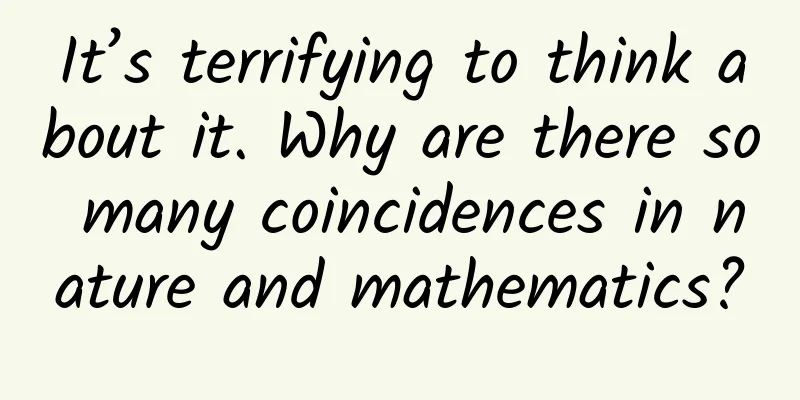It’s terrifying to think about it. Why are there so many coincidences in nature and mathematics?

|
The sun rises and sets, the grass grows and the birds fly. The various scenery of nature always inspires our desire to explore. In the process of getting close to nature, have you ever had a moment of doubt about various phenomena in nature? Why are honeycombs all hexagonal? Why do the curves of the nautilus shell and the golden ratio curve coincide perfectly? What is the relationship between Roman broccoli and the Fibonacci sequence? ...... Is it a coincidence that a seemingly random sketch of a natural scene actually contains such rich mathematical information? In this issue, the editor will take you into the "mathematical world of nature". You will never imagine that there are so many beautiful mathematical principles in nature. Secret sources in nature | Baidu Images 1 Why are honeycombs hexagonal? If you look at a beehive carefully, you will find that the "small rooms" inside the beehive are almost all hexagonal structures. Rows of hexagons are stacked on top of each other, eventually forming a neat and perfect honeycomb. Why is this so? This is the wisdom in the little brains of insects. Source | Baidu Images In the study of geometry, hexagons are the most efficient way to divide a surface into regions of equal area using the least total perimeter. This description is known as the "hexagonal honeycomb conjecture" and was proved by American mathematician Thomas Hales in 1999. Source | Baidu Images Under the same conditions, this structure requires the least amount of material. Therefore, the hexagonal shape of the honeycomb is the most cost-effective, using the least amount of beeswax and storing the most honey. 2 Why do the shell curve of the Nautilus and the golden ratio curve coincide perfectly? The nautilus is a marine mollusk whose shell is made up of a series of curved chambers that spiral outward from the center, gradually increasing in size. Source | Baidu Images It may be more intuitive to directly use a coordinate graph: Source | Baidu Images From the figure, we can see that any straight line passing through the origin always intersects the spiral at the same angle, and the length of each circle of the thread is equal to the sum of the lengths of the two circles inside; This perfect spiral is also called an equiangular spiral or a logarithmic spiral , and the equiangular spiral itself is closely related to the golden ratio. (The spiral angle of an equiangular spiral is generally 137.5°, and the more precise number is 137.50776°. It is known that 137.5=360-360*0.618, which is the golden ratio, so the angle of the equiangular spiral is also called the golden angle.) 3 Why are the periods of periodic cicadas always prime numbers? There is a type of cicada called periodical cicada. During the larval stage, it burrows underground. At some point many years later, it collectively breaks out of the ground, mates and reproduces, then dies, thus starting a new cycle. Source | Baidu Images Common periodic cicadas are said to have 17 years, and there are also 13 years. They are generally prime numbers . Why is this so? Let's talk about it slowly. Due to the characteristic that prime numbers can only be divided by themselves and 1, assuming that the life cycle of natural enemies is 4 years, then the 17-year cicada will only encounter one once in 68 years, and the 13-year cicada will only encounter one once in 52 years. Even if the factor of natural enemies is ignored, when the two periodic cicadas meet, they will also face the problem of competition for resources. In this case, the advantage of prime number periods is reflected. It will take 13*17=221 years for the 13-year cicada and the 17-year cicada to meet. Therefore, it can be said that the prime number period of this cicada is actually the result of natural selection. 4 What does the psychedelic curve of Romanesco broccoli represent? The Fibonacci sequence is a sequence in which each term is the sum of the previous two terms: 1, 1, 2, 3, 5, 8, 13, 21... Any number in it is called a "Fibonacci number". Fibonacci numbers are a common type of number in nature, and Roman broccoli illustrates this point perfectly. Each of its tower-shaped buds looks like a smaller version of the larger bud, and is also known as a "fractal vegetable." Why is that? Source | Baidu Images Roman broccoli is affected by growth genes, and the part that should have bloomed grows into buds. This not only increases the growth area of the buds, but also encourages it to continue to grow new buds, eventually forming a fractal spiral structure similar to the Fibonacci sequence. Not only Roman broccoli, but many plants in nature are closely related to the Fibonacci sequence, such as the number of various petals, the spiral number of pine cones, the vortex number of sunflower seeds , etc. Source | Baidu Images The existence of this number series allows plants to arrange themselves in an orderly manner, helping them to obtain more light and air and accumulate more organic matter and energy during the growth process. 5 Is there anything profound about the shape of the lotus pod? Think about the lotus pods we usually see. There are many small lotus seeds wrapped in a big lotus pod. This growth method actually corresponds to a mathematical problem, that is, **“big circle inside small circle”**. Source | Baidu Images N small circles are close together on a plane and do not overlap. How should they be arranged so that the area of the large circle wrapped outside is minimized and more space is saved? In relation to the lotus pod, their arrangement confirms this rule. The seeds of the lotus pod are not randomly long, each lotus seed is a small circle, and the big lotus pod is the smallest circle that can cover all the small circles. Source | Baidu Images 6 Why are many spider webs round? What do common spider webs look like in our daily lives? Think back, aren't they mostly circular? Radial spider silks extend out from the center at equal distances, connecting to form a large concentric circle web to capture prey. This radially symmetrical circular spider web is very stable, which helps to evenly distribute the impact force when the prey comes into contact with the web surface and reduces the chance of the spider silk breaking. Source | Baidu Images The world is so vast that there are so many wonders. The magic of nature is amazing. A small scene that we rarely pay attention to actually contains such a wonderful mathematical principle. Could it be that the Creator is also a mathematician? Otherwise, how could he integrate the beauty of mathematics so perfectly into nature? Audit expert: Liu Yuhang Postdoctoral fellow at Beijing International Center for Mathematical Research Source: Digital Beijing Science Center |
Recommend
Changes in advertising and marketing: Is “creativity” out of favor?
"Advertising is not art. The purpose of adve...
Useful information sharing: Let you learn JS closures in minutes
1. Closure, a sneak peek When I come into contact...
Exclusive interview: An article that helps you truly understand DSP advertising
Although DSP and information flow have been aroun...
How does an information flow optimizer who earns 20,000 yuan a month manage an account?
Today's content is a bit dry and a bit long, ...
Digital empowerment for healthy aging: Is it a good thing for the elderly to be “addicted” to the Internet?
Author: Fu Yi, attending physician at Tongji Hosp...
Analysis of Douyin short video competitors in 2019!
In this article, the author will analyze and comp...
7 proven growth strategies for startups!
If you are starting a business , you will definit...
What are the functions of the Campus Errands Mini Program? How much does it cost to create an errand running app?
Some time ago, a student came to us and said that ...
The inspiration for the mechanical "dragon" that can cross mountains and seas actually comes from insects?
Excerpted from: Inside and Outside the Classroom ...
Want to lose weight but keep getting fatter? Maybe you're not getting enough sleep
In Chinese food culture, rice and noodles are com...
Douyin 0-cost project: single-day income of 500, no posting of works, no account maintenance
One question that has always been mentioned in th...
Xpeng Motors: In June 2024, Xpeng Motors' deliveries reached 10,668 units, a year-on-year increase of 24%.
We learned from Xiaopeng Motors that its deliveri...
The Light of Creation: What insights does the past, present and future of light bring us?
Light is so common and yet so special. It is ever...
Wang Song Ao Han's all-round creative thinking course helps you build a creative IP and comprehensively improve your director's thinking
Wang Song Ao Han · All-round creative thinking co...
This private part of your body needs to be touched frequently, be careful of the sensation that may indicate cancer!
During physical examinations, many female friends...









